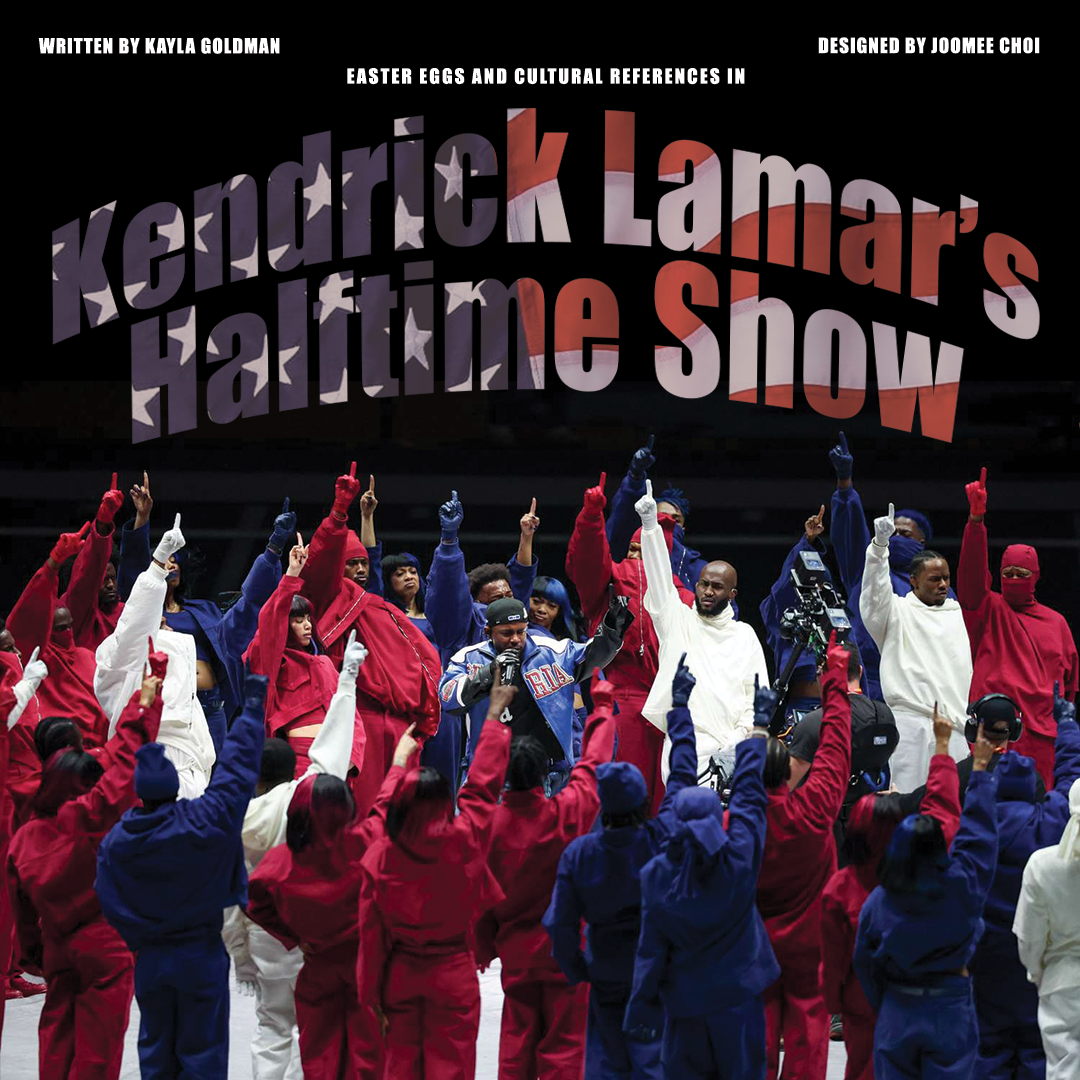
Kendrick Lamar was set to give a memorial performance during Super Bowl LIX, and he delivered with a show full of political messages and cultural pride. Lamar is known for his love of double entendres, and this show was filled with them, though many viewers missed the heavy symbolism of his performance.
Lamar recently won five Grammys, and his newest album, “GNX,” was No. 1 on the Billboard 200 for two nonconsecutive weeks starting Feb. 22. During his performance, Lamar brought SZA to the stage, the No. 2 ranked artist on the Billboard 200, to perform two of their collaboration songs, “luther” and “All the Stars.” This marks the first time the No. 1 and 2 artists have performed together at the Super Bowl Halftime Show.
Lamar had been hinting at an American theme since his announcement that he would be headlining, which featured a photo of him in front of a large American flag. During the show, his dancers were all adorned in red, white and blue sweatsuits. To start off the performance, the camera panned to actor Samuel L. Jackson, dressed as Uncle Sam, a symbol of American patriotism during World War I. After Jackson welcomed the audience to “The Great American Game,” Lamar began rapping on the video game controller stage beneath him. According to the show’s art director, Shelley Rodgers, in an interview with WIRED Magazine, the video game console idea was his connection between the concept of the American Dream and younger audiences.
As Lamar began, he paused his performance of “wacced out murals” to address the audience in a coded message: “the revolution about to be televised, you picked the right time but the wrong guy.” From the beginning, Lamar warned the audience that his performance was going to be highly politicized, and he would not hold back on account of President Donald Trump’s attendance.
Jackson’s representation of white America’s feelings towards Black hip-hop culture was prevalent throughout the show, as he used common phrases often heard in the media to describe Black music. Jackson went on to interrupt Lamar’s performances multiple times, telling him he was “too loud, too reckless, too ghetto” and he needed to “tighten up.”
One of Lamar’s most obvious political messages came in the form of an American flag created by his dance crew and their colored sweatshirts. The entourage split down the middle, and Lamar stood in the center rapping his hit song “HUMBLE.” His visual representation of America divided was an accurate depiction of the current polarization of beliefs and ideas in the country. Following this performance, Lamar moved stages, positioning himself in front of a group of his dancers wearing only white, singing “man at the garden,” a song whose main lyrics are “I deserve it all,” suggesting the idea of a white superiority complex. Jackson responded by calling this a “culture cheat code,” as the two teased at the feeling of connection white people tend to feel towards a song about wanting and needing more than others.
After teasing at the hit song throughout the performance, Lamar finally began his descent into the chaos of “Not Like Us.” The song includes lyrics accusing Drake of being a pedophile and a ‘colonizer’ of hip-hop culture,” according to NPR. The idea of colonization created the white America that still exists today, and Lamar used that idea in the song to add political depth to his messages towards Drake.
As his backup dancers asked, “you really ‘bout to do it?” he responded, “forty acres and a mule, this is bigger than influence.” Forty acres and a mule is a reference to the promises of retribution given to African Americans after they were freed from slavery. This promise was then rescinded when President Abraham Lincoln was assassinated and President Andrew Johnson returned the land to Confederate owners. Lamar used this line to symbolize the American government’s failed promises towards the Black community, as generational wealth in the early days of American history was incredibly hard for them to acquire.
Lamar’s next line is equally as meaningful, stating, “yeah they tried to rig the game but you can’t fake influence.” Though this is mostly geared towards Drake, this line could also be a jab at Trump’s claims of election fraud throughout his three elections.
During his performance of the hit song “Not Like Us,” Lamar didn’t hold back. Looking directly at the camera while saying Drake’s name, he smiled, challenging him to retaliate.
The dancers seemed to be scattered randomly, until they dropped to the floor — all except for the ones in white in the center of the stage, revealing a circle formation symbolizing the idea of an “inner circle,” once again using color imagery to represent the idea of white power.
The other large piece of symbolism present was the appearance of Serena Williams, champion U.S. tennis player. Williams only appeared for a couple of seconds, but she could be seen C-walking on a smaller stage above the rest of the floor. In the past, Williams has been heavily criticized by the media for C-walking following her gold medal Wimbledon win against Maria Sharapova in 2012. Commentators described her celebration dance as “crass and inappropriate,” according to Time Magazine.
Williams’ cameo marked a reckoning as she unapologetically embraced her and Lamar’s Compton culture on the big stage. This marked another push against white centered media, as Williams danced freely without fear of judgment.
Lamar’s performance was a true display of his cultural pride and how he embraces it. He stayed true to his roots while including significant political messaging throughout the show. His performance was poised, reminding many that any kind of music is an art form. In a pre-show interview with Apple Music, Lamar expressed his genuine love for the art of music.
“It puts the culture on the forefront where it needs to be, and not minimize … this is a true art form,” he said.